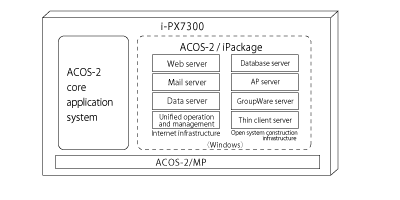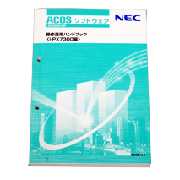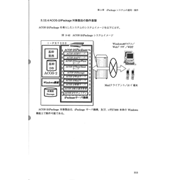ACOS-2/MP (which stood for “millennium processor”) was an operating system designed for NEC’s small mainframes. NEC announced the operating system in May 2000 and started shipments in July.
The operating system ran on the Parallel ACOS i-PX7300 series, which used Intel processors as their CPUs. NEC also provided the ACOS-2/iPackage product suite to bring core systems up to speed with the Internet age. The iPackage gave entire systems seamless connectivity with open systems, Internet support, and enhanced infrastructure functionality.
The main features of the operating system are given below.
- 1. Seamless connectivity with open systems
- ACOS-2/MP supported functions so that open systems could connect to and use data assets and application program assets on core systems.
- (1) File connectivity
- ACOS-2/MP provided the following functions to ensure interoperability between ACOS-2 core data (standard files) and Windows data in open environments.
- OLF/FL-RS: an application programming interface (API) for inputting and outputting ACOS-2 files from a Windows environment
- OLF/FL-RC: a function that enabled core application programs on ACOS-2 to access Windows files without requiring any modifications
- (2) Database connectivity
- ACOS-2/MP offered the following functions to make use of data from RIQSII databases.
- PC-RDB server: a set of APIs for accessing RIQSII databases from a Windows environment; specific APIs include a C-language API, a COM-compliant API, an ODBC interface, a Java interface, and a COBOL85 interface
- OLF/DB-EX: a function that, in one step, was able to extract data from a core database, transfer the data, and store the data in an open database (such Oracle)
- (3) Job connectivity
- ACOS-2/MP had the following functions to ensure access to application programs.
- OLF/JB-SV and OLF/JB-CL: two functions that connect execution control of application programs on ACOS-2 and on Windows
- Job input, status monitoring, and execution control using network queuing system (NQS)
- 2. Internet support
- ACOS-2/MP supported the following functions to enable convergence of core applications and Internet business environments.
- (1) Web connectivity
- The operating system enabled the use of core applications from Web browsers and i-mode terminals. The benefits included lack of any specialized software for each terminal, which lowered operating costs. The specific functions are listed below.
- ETOSWEB Server: executed ACOS-2 applications from a Web browser
- WEBharmo/RDB: constructed applications to access core databases from a Web environment
- ETOSJX for i-mode: constructed core applications that used i-mode terminals
- (2) Mail connectivity
- UXNET/ML enables sending email from an ACOS-2 application program, launching an application program on receipt of an email, and constructing applications centered on email.
- (3) Enhanced infrastructure functionality
- PWSS/SC: To enhance the execution environment for core applications, this function expanded the number of PWSS users and online terminals and beefed up security when accessing the core system. In addition to the management functions on the previous operating system, this function included unauthorized access monitoring, usage status monitoring, and encryption of client passwords to prevent the loss of information confidentiality.
CASEWORLD/PE: This function retained the DDA development functions from the previous operating system and provided new development tools for the increasingly popular Windows environments.




